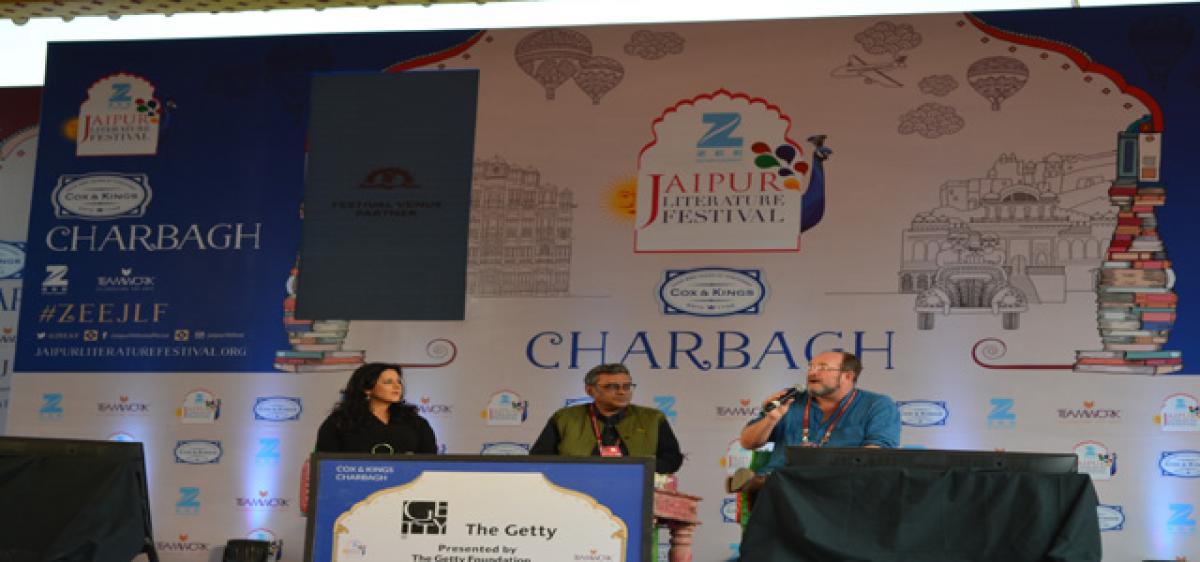Live
- Congress dares Kishan to bathe in Musi
- Kishan launches Musi Nidra programme
- ‘Yuva Utsav-2024’ commences
- Fire safety drill held at Secretariat
- Meru Srujan 2024: A Spectacular Celebration of Talent and Culture
- Representatives of VIDASAM demand resignation of YSRCP MLAs
- Police grill BRS leader Jaipal Yadav
- Revanth sells 6Gs to woo voters in Maharashtra
- Cong govt striking balance between welfare, devpt
- OU students stage protest over food poisoning
Just In

Authors, and historians William Dalrymple and Anita Anand’s ‘Kohinoor: The Story of the World’s Most Infamous Diamond’ puts many of the myths surrounding one of the prized processions of the British, and the most claimed jewel (while successive governments have spoken about bringing back the jewel to India where it belongs; Pakistan, Afghanistan, and even Taliban say that it is rightfully theirs w
Kohinoor: The Story of the World's Most Infamous Diamond' by William Dalrymple and Anita Anand reveals the trail of blood and murder surrounding the precious gem
Authors, and historians William Dalrymple and Anita Anand’s ‘Kohinoor: The Story of the World’s Most Infamous Diamond’ puts many of the myths surrounding one of the prized processions of the British, and the most claimed jewel (while successive governments have spoken about bringing back the jewel to India where it belongs; Pakistan, Afghanistan, and even Taliban say that it is rightfully theirs with each having their own story to claim so) – to rest.
Our job was to unemotionally strip away mythology and base our book on facts, they said. They use their extensive research and the limited factual information to chart out a story that in the first place puts forth the fact that Kohinoor was not stolen, but was in fact given away as a part of a treaty signed by Duleep Singh, one of the Successor to Ranjit Singh’s court at his fort in Lahore in return for protecting his kingdom.
Most of what we know of Kohinoor is a compilation of the many myths and stories (mostly gossip) surrounding the jewel that a young man, Theo Metcalfe, who was commissioned to do so during the time of Lord Dalhousie; a young ambitious general responsible for the treaty, was proud to have procured the diamond that by then had acquired enough fame and aura, and was in a way a symbol of India (though it is not the largest diamond). He sent it as a gift to Queen Victoria, even while his East India Company was not too happy with his decision.
Kohinoor reached England, but not before leaving behind a trail of death, blood and murder that will put ‘Game of Thrones’ to shame, shared Dalrymple. All the diamonds of the yore came from Golconda and were picked from the beds of extinct rivers, not mined.
While it is not known how it reached the Mughals, who were known for their craze for coloured stones like rubies, and diamonds only came send best for them – one of the first evidence of it is the peacock throne that Shah Jahan, made with Kohinoor placed on the top of the throne that resembles the one described as Solomon’s in Quran.
The tales of betrayal gore and death are many. It was a part of the war spoils that Nadir Shah took with him when he attacked Mughal Emperor Muhammed Shah Rangila; the famous successor of Aurangzeb, a patron of arts and a colourful personality that gave him the nickname ‘Sada Rangila’.
Nadir Shah was murdered, Shah Zaman Durrani, who was entrusted with the caretaking of the jewel was blinded by hot needles, the grandson of Nadir Shah, who was captive with eunuch was tortured, and had molten lead poured onto his head as a 'crown' to extract information about Kohinoor, Ranjit Singh’s sons were killed in freak accidents and murdered one after the other leaving the kingdom to the very young Duleep Singh vulnerable to treason and attack by the Britishers.
It was his mother Rani Jindan, the beautiful youngest queen of Ranjit Singh, who appointed herself as his reagent, and vowed to protect the kingdom for his son. A true “sherni” she was, describes Anita Anand.
However, the British lured the young nine-year-old Duleep Singh to give away Kohinoor in return for protecting his empire until he was 16. Queen Jindan was evidently against the treaty. She was imprisoned and separated from her son for 13 and half years. Duleep Singh grew to become a Christian and was admired by Queen Victoria herself.
The Queen never wore the jewel. There is yet another story of the ship that was carrying Kohinoor, which had its crew afflicted with cholera and dying on the way, and before it reached the shore was hit by a tornado. The leftover crew, who did manage to reach England, counted their lucky stars. The diamond grabbed headlines.
In England, Prince Albert held the famous exhibition of 1851 in London and kept the Kohinoor in a cage. People flocked to the exhibition, but Kohinoor looked more like a rock with absolutely no glitter unlike the European diamonds and failed to impress.
The prince much against the advice of experts commissioned the re-cut of the diamond and it was Duke of Wellington, who gave the first ceremonial cut. The diamond got its glitter but was reduced to more than half its original size (it is now 90 metric carats). By the way, the Duke, who gave the first cut never got to see the last cut. An expert horseman, he was mysteriously thrown over by his own horse and died.

© 2024 Hyderabad Media House Limited/The Hans India. All rights reserved. Powered by hocalwire.com







